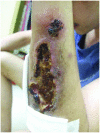Autologous immune enhancement therapy against an advanced epithelioid sarcoma: A case report
- PMID: 23761810
- PMCID: PMC3678875
- DOI: 10.3892/ol.2013.1247
Autologous immune enhancement therapy against an advanced epithelioid sarcoma: A case report
Abstract
Rare types of cancer are often not effectively treated by approaches such as chemotherapy and radio-therapy, although their side-effects persist. Immunotherapy has been gaining attention worldwide with growing examples of its anticancer activity demonstrated in vivo. This case report describes a 35-year-old male who suffered from advanced epithelioid sarcoma and underwent 18 cycles of chemotherapy without any significant response, who suffered adverse effects that caused lung collapse. A notable response was observed following the administration of autologous immune enhancement therapy (AIET), which involves a process of isolation, activation and expansion of natural killer (NK) and T cells, which were obtained from the patient's own (autologous) peripheral blood. With the present data and the response of the patient to AIET, it may be proposed that AIET is beneficial for patients suffering from advanced epithelioid sarcoma without producing adverse effects.
Keywords: T cells; advanced epithelioid sarcoma; adverse reactions; autologous immune enhancement therapy; natural killer cells.
Figures




References
-
- Demetri GD, Baker LH, Benjamin RS, et al. Soft tissue sarcoma. J Natl Compr Canc Netw. 2007;5:364–399. - PubMed
-
- Ferrari A, Miceli R, Casanova M, et al. The symptom interval in children and adolescents with soft tissue sarcomas. Cancer. 2010;116:177–183. - PubMed
-
- Cormier JN, Pollock RE. Soft tissue sarcomas. CA Cancer J Clin. 2004;54:94–109. - PubMed
-
- Brady MS, Gaynor JJ, Brennan MF. Radiation-associated sarcoma of bone and soft tissue. Arch Surg. 1992;127:1379–1385. - PubMed
LinkOut - more resources
Full Text Sources
Other Literature Sources
